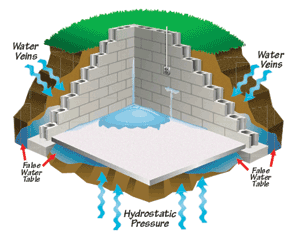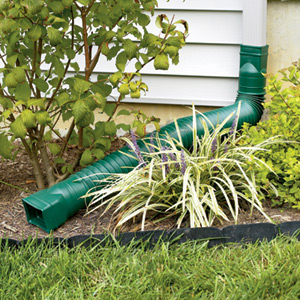Most Wet Basements Are A Result Of Hydrostatic Pressure
Hydrostatic pressure is what you get when there is a lot of water in the soil around your basement, and it is trying to force its way in through any crack or seam available. Hydrostatic pressure is also strong enough to actually create cracks in your foundation. Now remember that concrete is a porous material so moisture will eventually get through an 8" thick concrete wall, it's just a matter of time. Hydrostatic pressure is usually caused by improper water run-off. This means that the water that is running off of your roof gets dumped too close to the foundation, and the soil around the foundation absorbs the water, which collects along the outside perimeter of your foundation. There can be other reasons for improper water run-off, sometimes homes are located in a lowered region or valley, this will almost always cause water issues in your basement. Sometimes your neighbor is using drainage pipes to dump his water run-off into your yard. Soil conditions can also propose problems with water run-off.
The best remedy, (in my opinion) is to try to increase the water run-off rate. This is simple but will only work for homes that are not in a lowered region or valley. Check your gutters first, if the downspouts are ending right at the base of the foundation than you should add some extensions to the downspouts. Flexible plastic extensions are best, all you need to do is ensure that the extensions are dumping the gutter discharge at least 6 feet away form the foundation. Grading is also a good solution, This means that the surface of the earth or the soil should be sloping away from the foundation.
The slope should be 6" lower (meaning the surface of the ground) when you are standing 6 feet away from the foundation. You can also add a very thick layer of plastic around the foundation to prevent the soil around the foundation from absorbing water run-off. Cover the plastic with decorative rock or mulch to hide it, this will only work if the soil is sloping away from the house. If you are located in an area where the earth is sloping towards your house, the best solution will be to install a sump pump and install perforated type piping or absorption boxes on the inside perimeter of the entire basement. The piping or absorption boxes will collect most of the water trying to enter your house and be dumped into a sump tank, then the sump pump will pump the water far away from your house using a long hose or pipe. This type of project will require a licensed contractor that specializes in wet basement solutions. Remember to use our Automated Contractor Locating service if you want a professional basement remodeling contractor to help you with your remodel or basement waterproofing project. Simply fill out the form below.
|


 The saturability of soil plays an important role in how dry your basement will be. If the soil around your foundation is sandy than it will absorb water faster and dissipate it more evenly. If the soil around your foundation is very dense and has a high clay content than the water will not absorb into the earth as easily. Therefore if you have a dense soil condition in the area where your foundation wall meets the soil, there will be a place where water will tend to store itself. And because the soil absorption rate is so slow, the concrete wall will also begin to absorb the moisture and will result in a wet or damp basement.
The saturability of soil plays an important role in how dry your basement will be. If the soil around your foundation is sandy than it will absorb water faster and dissipate it more evenly. If the soil around your foundation is very dense and has a high clay content than the water will not absorb into the earth as easily. Therefore if you have a dense soil condition in the area where your foundation wall meets the soil, there will be a place where water will tend to store itself. And because the soil absorption rate is so slow, the concrete wall will also begin to absorb the moisture and will result in a wet or damp basement.